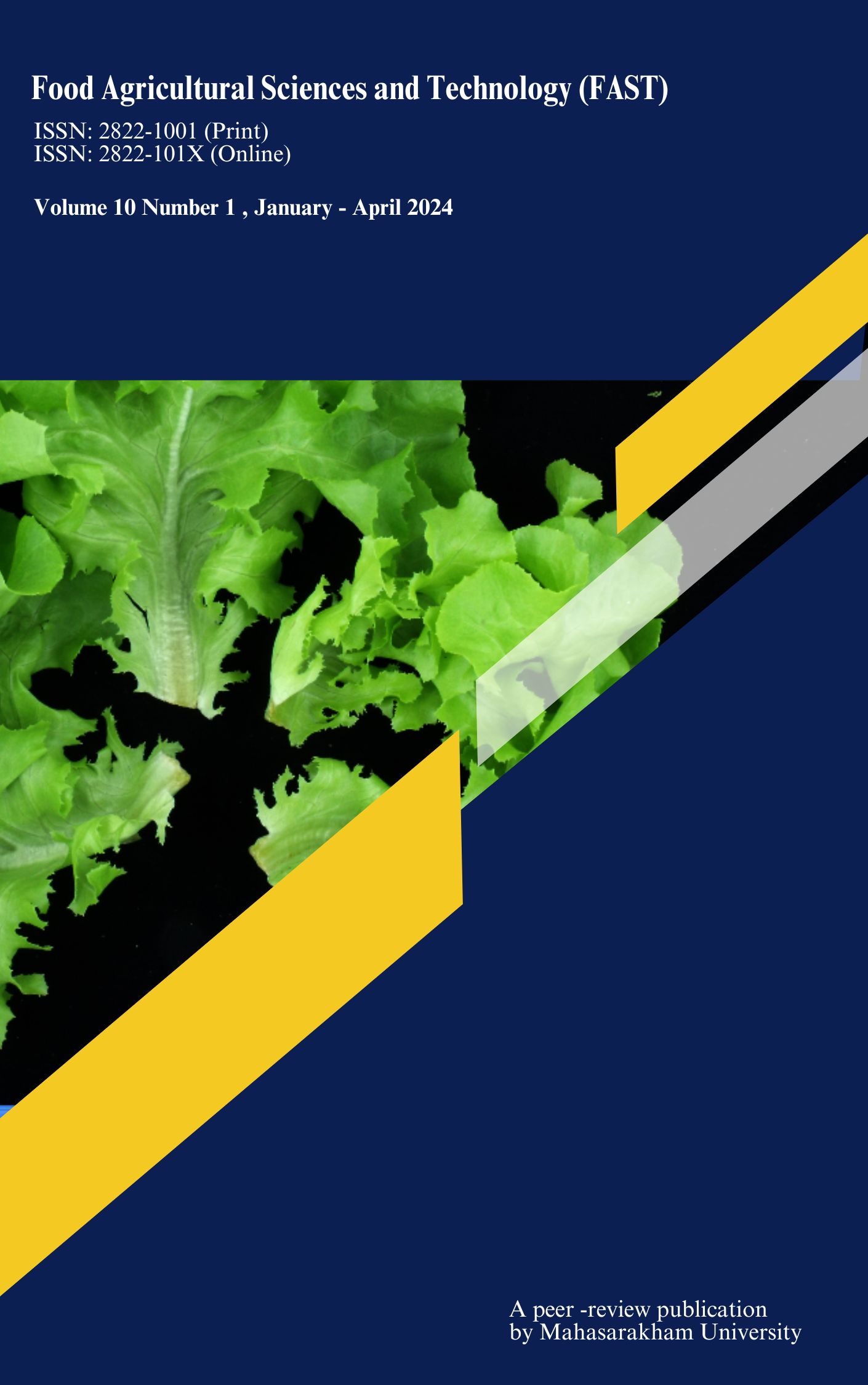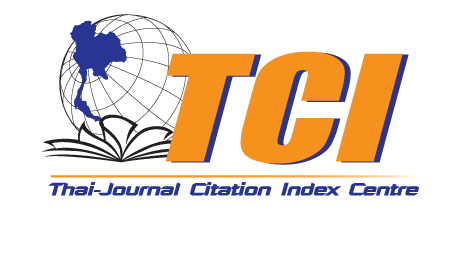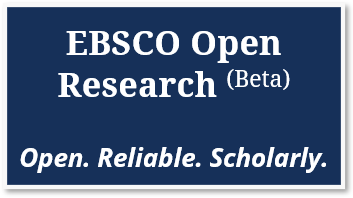Production of instant mixed-vegetables soup using foam mat drying: impact of various additives on foam properties and physicochemical aspects
Keywords:
Food powder, egg white albumin, carboxymethyl cellulose, glyceryl monostearate, maltodextrinAbstract
Nowadays, many consumers are paying attention to ready-prepared food containing nutritional and functionalities. The objective of this study was to develop an instant mixed-vegetable soup prepared by foam mat drying technique using various additives, e.g., egg white albumin (EA; 10-30%), carboxymethyl cellulose (CMC; 1-3%), and glyceryl monostearate (GMS; 10-30%) was used in combination with maltodextrin (MD; 10-30%) as a drying aid. The results showed that the cooked soup containing 76.99% carbohydrate, 16.98% protein, and 6.03% fat, in which dietary fiber equivalent to 1/3 of total carbohydrate (5.55 g dietary fiber and 17.93 g of carbohydrate). The application of 30% EA in combination with 10% MD showed the highest percentage of foam overrun (34.79 ± 0.30) and the product yield (12.54 ± 0.23), which experienced sensory qualities similar to a freshly cooked soup. The limitation of CMC led to a foam collapsing during drying, while GMS required long periods of drying time resulting in no production yield. The instant powder had a low percentage moisture content (<1%) and water activity (0.38) and could dissolve easily in hot water. The plant-based bioactive compounds such as chlorophyll a, b, and the total phenolic content were retained after processing. The strength of the product was lightweight and could be prepared by a simple technique with mild heat treatment. Moreover, it was convenient for individuals looking for time-saving, and reasonable for the elderly market section, specified for chewing difficulties.
References
Abd El-Salam, E. A. E.-S., Ali, A. M., & Hammad, K. S. (2020). Foaming process optimization, drying kinetics and quality of foam mat dried papaya pulp. Journal of Food Science and Technology, 58(4), 1449-1461. https://doi.org/10.1007/ s13197-020-04657-2
Anuradha, C., Selvarajan, R., Vasantha, S., & Suresha, G. S. (2015). Biochemical characterization of compatible plant virus interaction: A case study with bunchy top virus-banana host-pathosystem. Plant Pathology Journal, 14(4), 212-222. https:// doi.org/10.3923/ppj.2015.212.222
AOAC. (2000). Official methods of analysis (17th ed.). The Association of Official Analytical Chemists.
Bas-Bellver, C., Barrera, C., Betoret, N., & Seguí, L. (2020). Turning agri-food cooperative vegetable residues into functional powdered ingredients for the food industry. Sustainability, 12(4), 1284. https:// doi.org/10.3390/su12041284
BeMiller, J. N. (2019). Cellulose and cellulose-based hydrocolloids. Carbohydrate Chemistry for Food Scientists. Elsevier. https://doi. org/10.1016/b978-0-12-812069- 9.00008-x
Capasso, R., Izzo, A. A., Borrelli, F., Russo, A., Sautebin, L., Pinto, A., Capasso, F., & Mascolo, N. (2002). Effect of piperine, the active ingredient of black pepper, on intestinal secretion in mice. Life Sciences, 71(19), 2311-2317. https://doi. org/10.1016/s0024-3205(02)02019-2
Codex Alimentarius Commission. (2021). Endorsement and/or revision of maximum levels for food additives and processing aids in codex standards. https://www.fao.org/ fao-who-codexalimentarius/shproxy/ru/?lnk=1&url=https%253A %252F%252Fworkspace.fao. org%252Fsites%252Fcodex%252 FMeetings%252FCX-711-52%252F 2021SepWD%252Ffa52_05e.pdf
Đurović, S., & Blagojević, S. (2022). Composition and functionality of coriander essential oil. Asian Pacific Journal of Tropical Biomedicine, 5(6), 441-468. https:// doi.org/10.1201/9781003204626-38
Ekpong, A., Phomkong, W., & Onsaard, E. (2016). The effects of maltodextrin as a drying aid and drying temperature on production of tamarind powder and consumer acceptance of the powder. International Food Research Journal, 23(1), 300-308.
Falade, K. O., Adeyanju, K. I., & Uzo-Peters, P. I. (2003). Foam-mat drying of cowpea (Vigna unguiculata) using glyceryl monostearate and egg albumin as foaming agents. European Food Research and Technology, 217(6), 486-491. https://doi.org/10.1007/s00217- 003-0775-3
Falade, K. O., & Adeniyi, O. G. (2021). Instant soups from cowpea varieties using foam-mat drying. LWT, 151, 112191. https://doi.org/10.1016/j. lwt.2021.112191
Falade, K. O., & Adedeji, A. O. (2022). Effects of oven and foam mat drying on proximate, functional, and reconstitution characteristics of instant powders from selected legumes. Journal of Food Processing and Preservation, 46(6), e16545. https://doi.org/10.1111/ jfpp.16545
Gombart, A.F., Pierre, A., & Maggini, S. (2020). A review of micronutrients and the immune system-working in harmony to reduce the risk of infection. Nutrients, 12(1), 236. https://doi.org/10.3390/nu12010236
Górska-Warsewicz, H., Rejman, K., Kaczorowska, J., & Laskowski, W. (2021). Vegetables, potatoes and their products as sources of energy and nutrients to the average diet in Poland. International Journal of Environmental Research and Public Health, 18(6), 3217. https:// doi.org/10.3390/ijerph18063217
Hajiaghaei, M., & Sharifi, A. (2022). Physicochemical properties of red beetroot and quince fruit extracts instant beverage powder: Effect of drying method and maltodextrin concentration. Journal of Food Quality, 2022, 7499994. https:// doi.org/10.1155/2022/7499994
Huq, A. K. O., Rashid, R., Zubair, M. A., Rahman, A. K. M. M., & Rahman, M. M. (2018). Studies on the development of an instant food product (NUTRI-MASH) from plant sources and its clinical effects on health. The Journal of Social and Economic Development, 5(3), 291-294.
Jakkranuhwat, N., & Kunchansombat, P. (2021). Effect of foam-mat drying conditions on antioxidant activity, total phenolic compound, anthocyanin content and color of purple-fleshed sweet potato powder. Chiang Mai University Journal of Natural Science, 20(2), e2021045. https://doi.org/10.12982/ cmujns.2021.045
Jeong, Y., Yi, K., Hansana, V., Kim, J.-M., & Kim, Y. (2021). Comparison of nutrient intake in Lao PDR by the Korean CAN-Pro and Thailand INMUCAL analysis programs. Preventive Nutrition and Food Science, 26(1), 40-50. https://doi. org/10.3746/pnf.2021. 26.1.40
Jordan, I., Keding, G. B., Stosius, L., Hawrysz, I., Janiszewska, K., & Heil, E. A. (2021). Changes in vegetable consumption in times of covid-19—first findings from an international civil science project. Frontiers in Nutrition, 8, 686786. https://doi.org/10.3389/ fnut.2021.686786
Kandasamy, P., Varadharaju, N., Kalemullah, S., & Maladhi, D. (2012). Optimization of process parameters for foam-mat drying of papaya pulp. Journal of Food Science and Technology, 51(10), 2526-2534. https://doi. org/10.1007/s13197-012-0812-y
Kandasamy, P., Varadharaju, N., Kalemullah, S., & Maladhi, D. (2014). Optimization of process parameters for foam-mat drying of papaya pulp. J Food Sci Technol, 51(10), PMC4190251.
Kandasamy, P., Kumar, A., & Chakraborty, I. (2021). Analysis of foaming properties of mango pulp for foam-mat drying: impact of egg albumin concentration and whipping time. Journal of The Institution of Engineers (India): Series A, 103, 717-724. https://doi.org/10.36375/ prepare_u.iei.a187
Kanha, N., Regenstein, J. M., & Laokuldilok, T. (2020). Optimization of process parameters for foam mat drying of black rice bran anthocyanin and comparison with spray- and freeze-dried powders. Drying Technology, 40(3), 581-594. https://doi.org/10.1080/0737393 7.2020.1819824
Kaushal, M., Sharma, P. C., & Sharma, R. (2013). Formulation and acceptability of foam mat dried seabuckthorn (Hippophae salicifolia) leather. Journal of Food Science and Technology, 50(1), 78-85. https:// doi.org/10.1007/s13197-011-0236-0
Narsimhan, G., & Xiang, N. (2018). Role of proteins on formation, drainage, and stability of liquid food foams. Annual Review of Food Science and Technology, 9(1), 45-63. https://doi.org/10.1146/annurevfood-030216-030009
Ng, M. L., & Sulaiman, R. (2018). Development of beetroot (Beta vulgaris) powder using foam mat drying. LWT, 88, 80-86. https:// doi.org/10.1016/j.lwt.2017.08.032
Noordia, A., Mustar, Y. S., & Kusnanik, N. W. (2020). Foam mat drying of banana juice: varieties of ripe banana analysis and egg albumen foam. Food Science and Technology, 40(2), 465-468. https://doi. org/10.1590/fst.24918
Nurhadi, B., Roos, Y. H., & Maidannyk, V. (2016). Physical properties of maltodextrin DE 10: Water sorption, water plasticization and enthalpy relaxation. Journal of Food Engineering, 174, 68-74. https://doi. org/10.1016/j.jfoodeng.2015.11.018
Opazo-Navarrete, M., Burgos-Díaz, C., Soto-Cerda, B., Barahona, T., Anguita-Barrales, F., & Mosi-Roa, Y. (2021). Assessment of the nutritional value of traditional vegetables from southern chile as potential sources of natural ingredients. Plant Foods for Human Nutrition, 76(4), 523-532. https://doi.org/10.1007/s11130- 021-00935-2
Ozdikicierler, O., Dirim, S. N., & Pazir, F. (2014). The effects of spray drying process parameters on the characteristic process indices and rheological powder properties of microencapsulated plant (Gypsophila) extract powder. Powder Technology, 253, 474- 480. https://doi.org/10.1016/j. powtec.2013.12.004
Pérez-Gálvez, A., Viera, I., & Roca, M. (2020). Carotenoids and chlorophylls as antioxidants. Antioxidants, 9(6), 505. https:// doi.org/10.3390/antiox9060505
Rahman, M. S. (2007). Allicin and other functional active components in garlic: health benefits and bioavailability. International Journal of Food Properties, 10(2), 245-268. https://doi. org/10.1080/10942910601113327
Rao, Q., & Labuza, T. P. (2012). Effect of moisture content on selected physicochemical properties of two commercial hen egg white powders. Food Chemistry, 132(1), 373-384. https://doi.org/10.1016/j. foodchem.2011.10.107
Rohilla, S., & Mahanta, C. L. (2022). Foam mat dried tamarillo powder: Effect of foaming agents on drying kinetics, physicochemical and phytochemical properties. Journal of Food Processing and Preservation, 46(12). e17164. https://doi.org/10.1111/jfpp.17164
Sangamithra, A., S., Venkatachalam, S., John, S. G., & Kuppuswamy, K. (2014). Foam Mat Drying of Food Materials: A Review. Journal of Food Processing and Preservation, 39(6), 3165-3174. https://doi. org/10.1111/jfpp.12421
Sansomchai, P., Sroynak, R., & Tikapunya, T. (2023). Powder qualities of foam-mat dried mango. Trends in Sciences, 20(5), 5308. https://doi. org/10.48048/tis.2023.5308
Sinchaipanit, P., Sangsuriyawong, A., Visetchart, P., & Nirmal, N. P. (2023). Formulation of ready-toeat soup for the elderly: nutritional composition and storage stability study. Foods, 12(8), 1680. https:// doi.org/10.3390/foods12081680
Sifat, S. A. D., Trisha, A. T., Huda, N., Zzaman, W., & Julmohammad, N. (2021). Response surface approach to optimize the conditions of foam mat drying of plum in relation to the physical-chemical and antioxidant properties of plum powder. International Journal of Food Science, 2021, 3681807. https:// doi.org/10.1155/2021/3681807
Sonthipermpoon, W., Suwonsichon, T., S. Wittaya-areekul, & Wuttijumnong, P. (2006). Effect of maltodextrin on glass transition temperature and water activity of production banana flake. Agriculture and Natural Resources, 40(3), 708-715.
Stanaway, J. D., Afshin, A., Ashbaugh, C., Bisignano, C., Brauer, M., Ferrara, G., Garcia, V., Haile, D., Hay, S. I., He, J., Iannucci, V., Lescinsky, H., Mullany, E. C., Parent, M. C., Serfes, A. L., Sorensen, R. J. D., Aravkin, A. Y., Zheng, P., & Murray, C. J. L. (2022). Health effects associated with vegetable consumption: A burden of proof study. Nature Medicine, 28(10), 2066-2074. https://doi.org/10.1038/ s41591-022-01970-5
Susanti, D. Y., Sediawan, W. B., Fahrurrozi, M., & Hidayat, M. (2021). Foam-mat drying in the encapsulation of red sorghum extract: Effects of xanthan gum addition on foam properties and drying kinetics. Journal of the Saudi Society of Agricultural Sciences, 20(4), 270-279. https:// doi.org/10.1016/j.jssas.2021.02.007
Tapia, M. S., Alzamora, S. M., & Chirife, J. (2007). Effects of water activity (aw) on microbial stability: As a hurdle in food preservation. In Gustavo, V., Barbosa-Cánovas, Anthony J., Fontana Jr., Shelly J. Schmidt, Theodore P., & Labuza (eds.), Water Activity in Foods. https://doi. org/10.1002/9780470376454.ch10
Thakur, C., Verma, A. K., Sharma, P.C., Kaushal, M., Vaidya, D., Sharma, R.C., & Shivani. (2021). Effect of foaming agents on foaming properties, drying time and powder yield of rainy season Psidium guajava fruits cv. Shweta. The Pharma Innovation Journal, 10(6), 697-704.
Thuy, N. M., Giau, T. N., Tien, V. Q., Thanh, N. V., & Tai, N. V. (2023). Developing a nutritious soup product using purple sweet potatoes supplemented with composite of vegetables and freeze-dried chicken. Food Science and Technology, 43, e119922. https://doi.org/10.1590/ fst.119922
US Food and Drug Administration (USFDA). (2021). Dietary fiber. https://www.accessdata.fda.gov/ scripts/interactivenutritionfactslabel/ assets/InteractiveNFL_Dietary Fiber_October2021.pdf
Wahyuni, R., Wignyanto, W., Wijana, S., & Sucipto, S. (2021). Optimization of foam mat drying process of moringa leaf powder (Moringa oleifera) as protein and amino acids sources. Food Research, 5(2), 418-426. https://doi.org/10.26656/ fr.2017.5(2).539
Wei, X., Wang, H., Xie, Y., & Du, Y. (2020). An experimental investigation on the effect of carboxymethyl cellulose on morphological characteristics of dust-suppression foam and its mechanism exploration. Process Safety and Environmental Protection, 135, 126-134. https:// doi.org/10.1016/j.psep.2019.12.009
World Health Organization (WHO). (2014). Increasing fruit and vegetable consumption to reduce the risk of noncommunicable diseases. https:// www.who.int/tools/elena/bbc/ fruit-vegetables-ncds#:~:text= Current%20evidence%20indicates%20that%20fruits,cancer%20 (7%2C8)
World Health Organization (WHO). (2021a). Sodium carboxymethyl cellulose. https://apps.who.int/food-additivescontaminants-jecfa-database/Home/ Chemical/3773
World Health Organization (WHO). (2021b). Glyceryl monostearate. https://apps.who.int/food-additivescontaminants-jecfa-database/Home/ Chemical/30903
Yudhistira, B., Abigail, L. E., Siswanti, & Prabawa, S. (2020). The effect of blanching and foam mat drying on the physico-chemical characteristics of white sweet potato (Ipomoea batatas L.) inulin. Food Research, 4(5), 1493-1499. https://doi. org/10.26656/fr.2017.4(5).416
Yudhistira, B., Fatmawati, A., & Prabawa, S. (2023). Effect of temperature and foam mat drying method on the physical and chemical properties of white sweet potato (Ipomoea batatas L.) inulin. Food Research, 7(5), 332-338. https:// doi.org/10.26656/fr.2017.7(5).1010
Zeb, A. (2020). Concept, mechanism, and applications of phenolic antioxidants in foods. Journal of Food Biochemistry, 44(9), e13394. https:// doi.org/10.1111/jfbc.13394
Zhou, J., Yang, Q., Zhu, X., Lin, T., Hao, D., & Xu, J. (2020). Antioxidant activities of Clerodendrum cyrtophyllum Turcz leaf extracts and their major components. Plos One, 15(6), e0234435. https://doi. org/10.1371/journal.pone.0234435
Downloads
Published
How to Cite
Issue
Section
License
Copyright (c) 2023 Food Agricultural Sciences and Technology

This work is licensed under a Creative Commons Attribution-NoDerivatives 4.0 International License.








